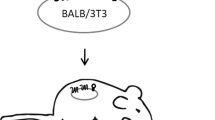Abstract
Soluble protein antigens do not stimulate helper or effector T lymphocytes unless they have first been processed and exposed to the T lymphocytes by appropriate antigen-presenting cells. This antigen presentation was found to be controlled by products of genes in the major histocompatibility complex (MHC), designated H–2 in the mouse. Efficient antigen presentation to T lymphocytes is obtained only when both presenting and responding cells share alleles within the I region of the MHC1. Furthermore, immune response (Ir) genes in the MHC influence the choice of antigenic determinants recognized on the immunogenic molecule2. To investigate the molecular mechanisms underlying Ir gene expression, we have inserted membrane components isolated from cells of one Ir genotype into recipient cells of a different Ir genotype, using membrane vesicles composed of donor plasma membranes and envelope glycoproteins from Sendai virus3. We now report that this ‘membrane-engineering’ enables genetically inappropriate antigen-presenting cells to communicate to T lymphocytes antigenic determinants of beef or sheep insulins, antigens under control of Ir genes in mice4. This demonstrates that structural products of MHC genes, expressed and active at the plasma membrane, function in the Ir phenotype of the response to insulin.
This is a preview of subscription content, access via your institution
Access options
Subscribe to this journal
Receive 51 print issues and online access
$199.00 per year
only $3.90 per issue
Buy this article
- Purchase on Springer Link
- Instant access to full article PDF
Prices may be subject to local taxes which are calculated during checkout
Similar content being viewed by others
References
Yano, A., Schwartz, R. H. & Paul, W. E. J. exp. Med. 146, 828–843 (1977).
Rosenthal, A. S., Barcinski, M. A. & Blake, J. T. Nature 267, 156–158 (1977).
Prujansky-Jakobovits, A., Volsky, D. J., Loyter, A. & Sharon, N. Proc. natn. Acad. Sci. U.S.A. 77, 7247–7251 (1980).
Keck, K. Eur. J. Immun. 7, 811–816 (1977).
Cohen, I. R. & Talmon, J. Eur. J. Immun. 10, 284–289 (1980).
Snell, G. D. Immun. Rev. 38, 3–69 (1978).
Taylor, R. B., Duffus, W. P. H., Raff, N. C. & De Petris, S. Nature new Biol. 233, 225–229 (1971).
Bach, F. H., Widmer, M. B., Bach, M. L. & Klein, J. J. exp. Med. 136, 1430–1444 (1972).
Osborne, D. P. Jr & Katz, D. H. J. exp. Med. 138, 825–838 (1973).
Katz, D. H. & Benacerraf, B. Transplantn Rev. 22, 175–195 (1975).
Author information
Authors and Affiliations
Rights and permissions
About this article
Cite this article
Jakobovits, A., Frenkel, A., Sharon, N. et al. Inserted H–2 gene membrane products mediate immune response phenotype of antigen-presenting cell. Nature 291, 666–668 (1981). https://doi.org/10.1038/291666a0
Received:
Accepted:
Issue Date:
DOI: https://doi.org/10.1038/291666a0
This article is cited by
Comments
By submitting a comment you agree to abide by our Terms and Community Guidelines. If you find something abusive or that does not comply with our terms or guidelines please flag it as inappropriate.



